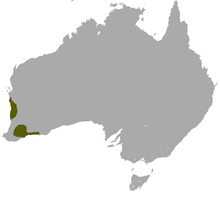White-tailed dunnart
| White-tailed dunnart | |
|---|---|
| Scientific classification | |
| Kingdom: | Animalia |
| Phylum: | Chordata |
| Class: | Mammalia |
| Infraclass: | Marsupialia |
| Order: | Dasyuromorphia |
| Family: | Dasyuridae |
| Genus: | Sminthopsis |
| Species: | S. granulipes |
| Binomial name | |
| Sminthopsis granulipes Troughton, 1932 | |
 | |
| White-tailed dunnart range | |
The white-tailed dunnart (Sminthopsis granulipes), also known as the ash-grey dunnart, is a dunnart native to Australia.[2] It has an average body length of 126–168 mm (5.0–6.6 in), a snout to anus length of 70–100 mm, a tail measurement of 56–68 mm and a weight which varies between 18 and 35 grams (0.6 and 1.2 oz). The tail is often swollen at the base with brown near anus to white at the tip.
Distribution and habitat
This dasyurid occupies two separate areas in Western Australia. The first is east of Perth in the western Goldfields area and the second is to the north of Perth between Kalbarri and Jurien Bay. Habitat consists of coastal heath and sparse to dense shrublands sometimes with mallee eucalypt.
Social organisation and breeding
Little is known of the behaviour and breeding of this marsupial, though it is most likely nocturnal. It breeds from June through August with young weaned by October.
Diet
The white-tailed dunnart mainly eats insects.
References
- ↑ McKenzie, N. (2008). "Sminthopsis granulipes". IUCN Red List of Threatened Species. Version 2008. International Union for Conservation of Nature. Retrieved 28 December 2008.
- ↑ Groves, C.P. (2005). "Order Dasyuromorphia". In Wilson, D.E.; Reeder, D.M. Mammal Species of the World: A Taxonomic and Geographic Reference (3rd ed.). Johns Hopkins University Press. p. 34. ISBN 978-0-8018-8221-0. OCLC 62265494.
Sources
- Menkhorst, P.; Knight, F. (2001). A field Guide to the Mammals of Australia. Oxford Press. p. 68. ISBN 0-19-550870-X.
- Groves, C.P. (2005). Wilson, D.E.; Reeder, D.M., eds. Mammal Species of the World: A Taxonomic and Geographic Reference (3rd ed.). Baltimore: Johns Hopkins University Press. p. 34. ISBN 0-801-88221-4. OCLC 62265494.
